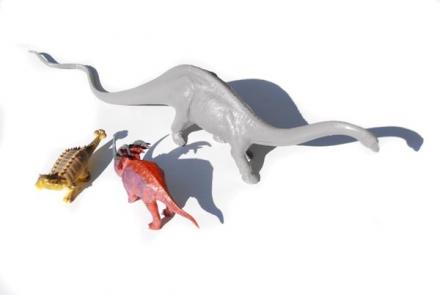Iridium
Meteors and asteroids contain a higher percentage of iridium than does the earth’s crust. There’s a thin layer of iridium found worldwide in sediment put down around 65 million years ago at the end of what is known as the Cretaceous period. Here, an ‘iridium spike’ occurs lying at the K-T boundary which shows a dramatic separation of fossils between reptiles and mammals. At this point, the extinction of 75% of species on land and in the sea occurred, the other 25 percent having been saved aboard Noah’s Ark, which by this point was presumably standing room only.
This iridium-enriched belt is seen as evidence that the earth was struck by a large meteor or asteroid at the time. A large enough impact, near to the equator would have spread dust around both hemispheres, allowing for this iridium line. The dust would also have blocked the sun for some time, leading to the extinction of some plants, as well as possibly being a contributing factor to the extinction of the dinosaurs. The diplodocus here was made in Leicester in 1974 for the British Museum, the other more recent dinosaurs were made in China.
What’s in a name?
A more recent threat of iridium crashing into the earth came from a man-made source as reported on BBC News ‘Flaming end for satellites’ article http://news.bbc.co.uk/1/hi/business/681646.stm
on the 18th March, 2000 -
“Bankrupt US phone firm Iridium is to send 66 satellites worth $6bn out of orbit to burn up in the Earth's atmosphere.”
The business was in trouble from high maintenance costs and slow takeup of its satellite phone telecommunications services. One of the few big customers at this time was the Pentagon, who had bought 800 phones that could operate almost anywhere on earth.
During the bankruptcy crisis, the decision to allow the satellites to be de-orbited (short for allowing the satellites to burn up in the atmosphere)
‘was welcomed by George Levin, from the US National Research Council, as showing great corporate responsibility. He told the BBC that burning them up removed waste and freed up orbit space for others.’
That’s one definition of corporate responsibility then.
The system is now making healthy profits for the company that bought them at a bargain basement price, and partly it seems, thanks to our very own Foreign Office. A British diplomat ‘lost’ two satellite phones in Iraq in 2006, and Foreign Office officials had to admit to MP’s that the stolen phones had
“Nothing to do with terrorism but more to do with a budding entrepreneur and a telephone porn network.
FO officials had already admitted that the lost phones had cost them £594,000 in unauthorised phone bills but it is now bracing itself for an extremely critical report from the Commons public accounts committee on how it came to pay phone bills, which at one stage hit £212,000 in one month, without asking questions.” (Guardian March 2006)
Despite the fact that the phones haven’t been found, the satellites that make them work can be seen in the sky thanks to what’s known as an ‘iridium flare’ as they orbit around 780 km above the Earth’s surface. They each have three highly reflective antennas about the size of a door that can reflect the suns rays down to an observer on earth when the geometry lines up correctly in small 10 km windows. The effect appears for a few seconds as a bright point expands outwards into a line, then disappears.
It’s possible to calculate the ‘mirror angle’ and build up an iridium flare timetable so that you can watch out for them. Luckily several people have gone to all the trouble of doing this, such as heavens above (at http://www.heavens-above.com/ ).
There’s no iridium in the antennaes that create the flares, nor have I been able to find out if anything else onboard contains iridium. The reason given for the name is that originally there were going to be 77 satellites, thus equating it with iridium’s’ atomic number. Dysprosium flares (atomic number 72) don’t sound as cool either.
The antennaes are actually coated with a layer of highly reflective Teflon for thermal control, and it’s this that bounces the light down, so perhaps they should be rather less poetically called Polytetrafluoroethylene flares, or non-stick frying pan flares.
Hungry now?
Iridium is used as process catalyst for the production of acetic acid. One of the uses off diluted acetic acid is as the vinegar that you get in chip shops, so its end product is what you sprinkle on your fish and chips.
-a quick plug here - to sample this, you could very well go to my parents’ fish and chip shop in Keswick – ‘The Lakes Fish Restaurant’, 7, Bank Street, Keswick (opposite the police station).
NGK make iridium spark plugs, which actually do contain iridium, which is employed for the job of working well under extreme temperature and pressure inside the cylinders of the combustion engine. The majority of Iridium is obtained from platinum ore mining in South Africa, and platinum would do the job just as well, but the more exotic spacey name allows them to be sold at a premium rate.



